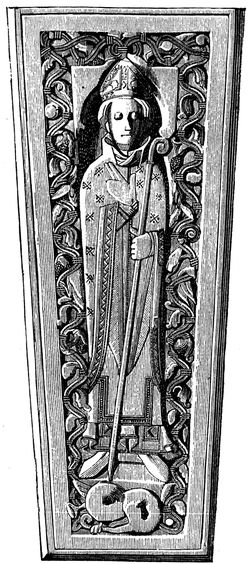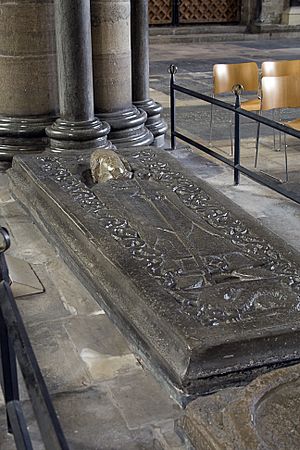Roger of Salisbury facts for kids
Quick facts for kids Roger of Salisbury |
|
|---|---|
| Bishop of Salisbury | |

Monument of Roger, Bishop of Salisbury (died 1139), in his cathedral church.
|
|
| Appointed | 29 September 1102 |
| Reign ended | 11 December 1139 |
| Predecessor | Osmund |
| Successor | Henry de Sully |
| Orders | |
| Consecration | 11 August 1107 |
| Personal details | |
| Died | 11 December 1139 Salisbury |
| Denomination | Catholic |
Roger of Salisbury (died 1139) was an important figure in medieval England. He was a Norman priest who became the bishop of Salisbury. He also served as the seventh Lord Chancellor and a powerful advisor to the king.
Contents
Life and Career
Roger started as a priest in a small church near Caen in Normandy. One day, the future King Henry I heard him lead a church service. Henry was impressed by how quickly Roger read the prayers. Because of this, Henry asked Roger to join his royal service.
Becoming a Royal Advisor
Even though Roger did not have a lot of formal education, he was very good at managing things. When Henry I became king, he quickly made Roger his Lord Chancellor in 1101. This was a very important job, like being the king's main secretary and legal advisor. Roger held this position until late 1102.
On September 29, 1102, Roger was chosen to be the bishop of Salisbury. However, he wasn't officially made bishop until August 11, 1107. This delay was because of a disagreement between King Henry and Archbishop Anselm. This disagreement was known as the Investiture Controversy, which was about who had the right to appoint church leaders. Roger was very skilled and managed to stay on good terms with both the king and the archbishop during this time.
Building the Government System
Roger spent a lot of his time working on how the government was run. He completely changed and improved the way things were done. He helped create the exchequer system, which was like the country's treasury and accounting department. Roger and his family managed this system for over a hundred years. He used his important position to gain a lot of power and wealth.
Roger often ruled England when King Henry I was away in Normandy. He was a very trusted advisor. After Henry I died in 1135, Roger supported Stephen as the new king. Roger brought the royal treasury and the entire government system over to Stephen's side. King Stephen relied heavily on Roger and his family members, including his nephews, who were also bishops, and his own son, who was the treasurer.
Conflict with King Stephen
King Stephen once said that Roger could have half the kingdom if he asked for it. However, Stephen also felt that Roger and his family had too much influence. Roger had built a very impressive castle called Devizes Castle, which was considered one of the best in Europe. He and his nephews also controlled several other castles. Roger acted almost as if he were as powerful as the king himself.
In June 1139, King Stephen found a reason to demand that Roger and his family give up their castles. When they refused, they were arrested. After a short struggle, all of Roger's large castles were taken by the king. This action caused a big problem with the church, as many people believed the king should not harm church leaders.
Roger of Salisbury did not live to see the end of these troubles. He died on December 11, 1139.
Roger's Legacy
Roger was a very talented administrator and builder. He helped create a strong government system for England. He was known for being very involved in worldly affairs, meaning he focused a lot on government and money rather than just church matters.
Roger had several important family members. His nephew, Alexander, became the bishop of Lincoln. Another nephew, Nigel of Ely, became the bishop of Ely. Roger's son, Roger le Poer, served as Lord Chancellor for King Stephen.
See also
 In Spanish: Roger de Salisbury para niños
In Spanish: Roger de Salisbury para niños


